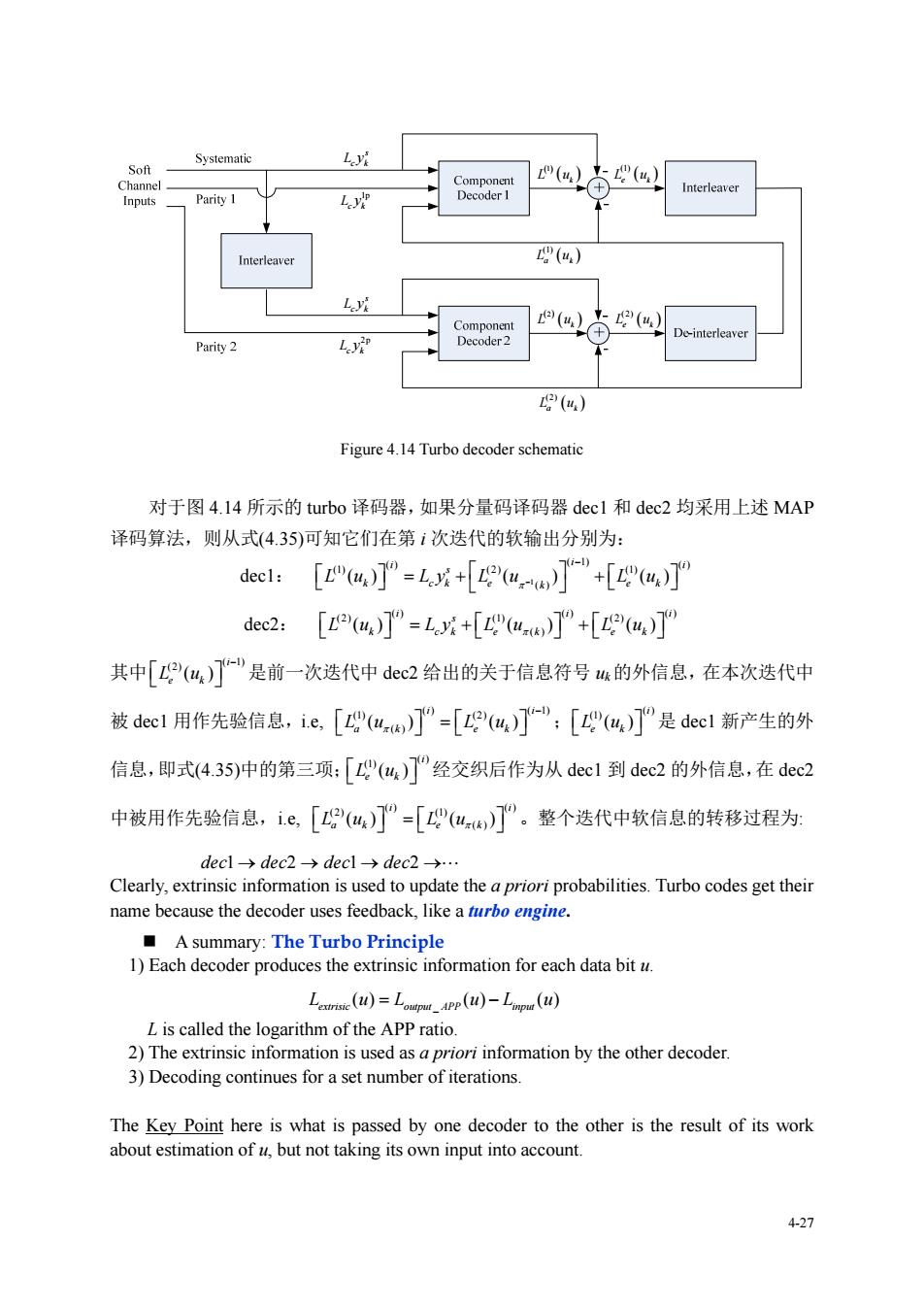正在加载图片...

arity 1 De-interleave (4) Figure 4.14 Turbo decoder schematic 对于图4.14所示的turbo译码器,如果分量码译码器decl和dec2均采用上述MAP 译码算法,则从式(4.35)可知它们在第1次迭代的软输出分别为: deel:[(u dec2:[Eu)]°=L+[zu】”+[z2(u,j] 其中[2(u:)]是前一次迭代中dcc2给出的关于信息符号,的外信息,在本次迭代中 被dec1用作先验信息,ie,[Luu”=[Lu,)]-:[u,)”是decl新产生的外 信息,即式(4.35)中的第三项:[L(u)经交织后作为从dec1到dec2的外信息,在dec2 中被用作先验信息,iC,[(u)]”=[(4)]”。整个迭代中软信息的转移过程为: decl→dec2→decl→dec2→. Clearly,extrinsic information is used to update the aprioriprobabilities.Turbo codes get their name because the decoder uses feedback,like a turbo engine. Asummary:The Turbo Principle 1)Each decoder produces the extrinsic information for each data bit u. Louse(0)=Lopd.Arp(0)-Lrpr()) L is called the logarithm of the APP ratio. 2)The extrinsic information is used as a priori information by the other decoder. 3)Decoding continues for a set number of iterations. The Key Point here is what is passed by one decoder to the other is the result of its work 427 4-27 1 k L u (1) e k L u 2 k L u (1) a k L u (2) a k L u s c k L y 1p c k L y s c k L y 2p c k L y (2) e k L u Figure 4.14 Turbo decoder schematic 对于图 4.14 所示的 turbo 译码器,如果分量码译码器 dec1 和 dec2 均采用上述 MAP 译码算法,则从式(4.35)可知它们在第 i 次迭代的软输出分别为: dec1: 1 ( 1) () () (1) (2) (1) ( ) () ( ) () i i i s k ck e e k k L u Ly L u L u dec2: () () () (2) (1) (2) ( ) () ( ) () i ii s L u Ly L u L u k ck e k e k 其中 ( 1) (2) ( ) i L u e k 是前一次迭代中 dec2 给出的关于信息符号 uk的外信息,在本次迭代中 被 dec1 用作先验信息,i.e, ( ) ( 1) (1) (2) ( ) ( ) () i i Lu Lu a k ek ; ( ) (1) ( ) i L u e k 是 dec1 新产生的外 信息,即式(4.35)中的第三项; ( ) (1) ( ) i L u e k 经交织后作为从 dec1 到 dec2 的外信息,在 dec2 中被用作先验信息,i.e, () () (2) (1) ( ) () ( ) i i Lu Lu ak e k 。整个迭代中软信息的转移过程为: dec dec dec dec 1212 Clearly, extrinsic information is used to update the a priori probabilities. Turbo codes get their name because the decoder uses feedback, like a turbo engine. A summary: The Turbo Principle 1) Each decoder produces the extrinsic information for each data bit u. L is called the logarithm of the APP ratio. 2) The extrinsic information is used as a priori information by the other decoder. 3) Decoding continues for a set number of iterations. The Key Point here is what is passed by one decoder to the other is the result of its work about estimation of u, but not taking its own input into account. _ () () () L uL uL u extrisic output APP input